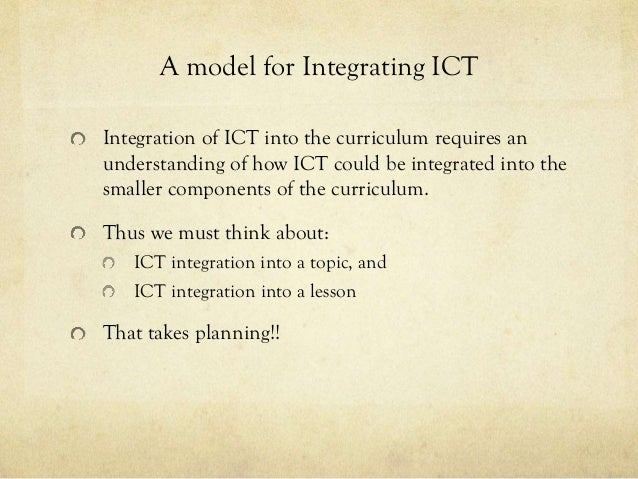Integrating a curriculum with technology involves making technology into a tool to enhance learning in a content area or multidisciplinary setting. The technology should become an integral part of how the classroom functions, as accessible as all other classroom tools.
The teachers’ curriculum is considered a significant vehicle for the realisation of the goals of the National Curriculum Framework and consequently is designed to provide an enhanced exposure to information and resources for ongoing professional support, improved teaching-learning-evaluation-tracking, and increased productivity. The National Policy on ICT in School Education organises the competencies for ICT Literacy into three broad levels, basic, intermediate and advanced, and the curriculum subsumes them.
Integrating Ict Into Historyeffective Curriculum Ideas 4th Grade
- Workshop on ICT-pedagogy Integration A 5-day workshop for teacher educators of TEIs focusing (one for each of the TEIs of the target country) on ICT-pedagogy integration. Effective (training) strategies on how to use ICT into different pedagogy: Pedagogical principles, supporting examples, appropriate tools, etc.
- Integrating ICT in to the Curriculum Slideshare uses cookies to improve functionality and performance, and to provide you with relevant advertising. If you continue browsing the site, you agree to the use of cookies on this website.
Stage 1
Basic Basics of computers and basic use of tools and techniques – operate a computer, store, retrieve and manage data, use a computer to achieve basic word and data processing tasks; connect, disconnect and troubleshoot basic storage, input and output devices. Connect to the internet, use e-mail and web surfing, use search engines; keep the computer updated and secure; operate and manage content from external devices (sound recorders, digital cameras, scanners etc.); connect, disconnect, operate and troubleshoot digital devices.
Stage 2
Intermediate Create and manage content using a variety of software applications and digital devices; using web sites and search engines to locate, retrieve and manage content, tools and resources; install, uninstall and troubleshoot simple software applications.
Stage 3
Advanced Use different software applications to enhance one’s own learning – database applications, analysis of data and problem solving, computing, design, graphical and audio-visual communication; undertake research and carry out projects using web resources; use ICT for documentation and presentation; create and participate in web based networks for cooperative and collaborative learning; become aware of issues of cyber security, copyright and safe use of ICT and take necessary steps to protect oneself and ICT resources
The content of the curriculum involves activities which simultaneously draw upon competencies from different levels, such that a completion of all levels is ensured. The ICT in Education curriculum broadly attempts to equip teachers with ICT competencies to strengthen their own professional capacities and to effectively use ICT tools and devices in their teaching- learning. Teacher will also be trained to manage the ICT environment in the school and function as a local coordinator for organising capacity building programmes.
The curriculum therefore is rolled out as a series of short courses, spanning the six strands and ensuring together the basic, intermediate and advanced levels of competence. Three induction and twenty refresher courses leading to a diploma in ICT in Education is proposed. Induction courses are to be conducted in face to face mode whereas State (SCERTs/ SIEs) may chose to conduct the refreshers in face to face or in online mode.
● Induction 01* (For beginners) – 10 days (4 credits)
● Refresher 01 -10 (For all teachers) – Each refresher 40 hours: 24 hrs of transaction and 16 of project & presentation (20 credits)
Integrating Ict Into Historyeffective Curriculum Ideas Examples
● Induction 02 (For all teachers) – 5 days (4 credits)
(*Note – A large number of teachers are likely to have been trained or acquired qualifications making them advanced users of ICT. Such teacher shall be permitted to complete all activities and assignments populating their e-portfolio at their own pace without attending the face to face training.)
In addition, advanced refreshers (11-20) and induction 03 are available to extend teachers a range of exposure to ICT. State may choose some or all based on the availability of time/ resources. Refresher 14 to 17 will include optional courses; a number of subject specific courses will be offered under the advanced refreshers so that the teacher may choose minimum of any four courses from them. Based on developments in the field of ICT and ICT in Education, newer modules will be continuously added and teachers can be encouraged to undertake the module.


Objectives
After undergoing this course the teacher will be able to:
1. Effectively use ICT tools, software applications and digital resources
2. Integrate ICT into teaching-learning and its evaluation
3. Acquire, organize and create her own digital resources
4. Participate in the activities of teachers’ networks
5. Participate in the evaluation and selection of ICT resources
Integrating Ict Into Historyeffective Curriculum Ideas Preschool
6. Practice safe, ethical and legal ways of using ICT
Integrating Ict Into Historyeffective Curriculum Ideas 5th
7. Use ICT for making classroom processes more inclusive and to address multiple learning abilities


